| Differential Reliability | Cumulative Reliability |
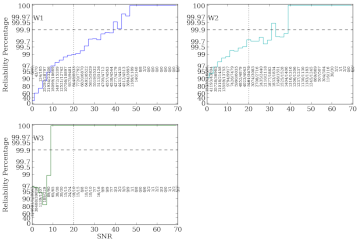 |
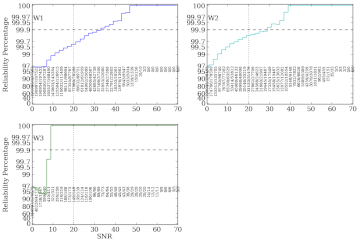 |
| Figure 1 - Example Data for Region 2 | |



Reliability is a metric used to indicate the fraction of sources listed in the 3-Band Cryo Data Release Source Working Database (hereafter "3-Band WDB") that were detected above a given signal-to-noise threshold that are real astrophysical sources.
There are no specific requirements that pertain to the reliability of the 3-Band WDB, but we use the All-Sky Release Source Catalog ("All-Sky Catalog") requirements as a reference.
Please see the discussion of the All-Sky Catalog requirements for information on how these requirements are interpreted.
For all intents and purposes, the reliability of the 3-Band Database, when subject to the same selection criteria as the All-Sky Catalog, is identical to the All-Sky Catalog. This is due to the fact that the vast majority of the sources in the catalog/database are detected in W1 and W2, and the general behavior of the W1 and W2 detectors during the 3-Band phase of the mission was little changed from the full 4-band cryogenic survey. Therefore, we expect to (and do) see very similar behaviors in the reliability properties of both portions of the mission.
To confirm the similarity of the 3-Band WDB to the All-Sky Catalog, we analyze the 3-Band data using the same three techniques described for the All-Sky Catalog: a WISE-internal comparison using the All-Sky Catalog as the truth table, a WISE-to-2MASS comparison, and a WISE-to-Spitzer comparison. Wherever possible, the same scripts that were used to analyze the All-Sky reliability were used to judge the 3-Band reliability. As was the case for the All-Sky Catalog, the reliability is found to be at least 99.9% for objects with SNR > 20 in all three tests, with the same caveats as for the All-Sky Catalog. Please refer to the All-Sky reliability commentary for a full description of the techniques and caveats; they are not repeated here since they are identical.
Note 1: The unusual vertical scale in the following plots is identical to that used in the All-Sky analysis. Please see the discussion in Note 1 of that section.
Rather than using specially processed tiles from the ecliptic poles as was done for the All-Sky internal analysis, here we use the All-Sky Catalog itself as the truth table. Sources were selected from 7 of the Test Regions (2 and 13 through 18) where there was overlap between the 3-Band and All-Sky surveys. (Even though Region 6 is common, it contains the Galactic plane and is highly confused.)
Over 1 million sources were compared between the two catalogs. The results of this comparison are demonstrated in the following figures from two of the Test Regions. Figure 1 presents differential and cumulative reliability derived from the Region 2 field, while Figure 2 shows the equivalent data from the Region 15 field.
| Differential Reliability | Cumulative Reliability |
 |
 |
| Figure 1 - Example Data for Region 2 | |
| Differential Reliability | Cumulative Reliability |
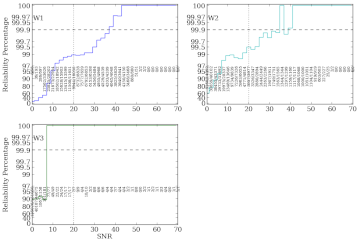 |
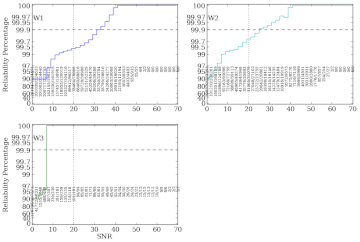 |
| Figure 2 - Example Data for Region 15 | |
The trends in these plots are nearly identical to those in Figures 1 and 2 of the All-Sky discussion. An examination of the images shows the identical spatial resolution and confusion issues noted in Figures 3 and 6 of the All-Sky analysis. When corrected for blending, the plots match the corrected plots in the All-Sky extremely well.
| Differential Reliability | Cumulative Reliability |
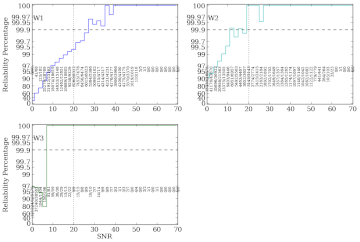 |
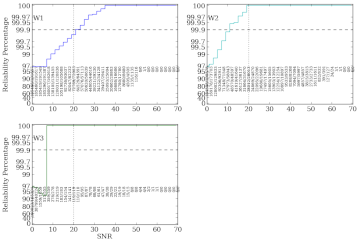 |
| Figure 3 - Example Data for Region 2, filtered for blends | |
| Differential Reliability | Cumulative Reliability |
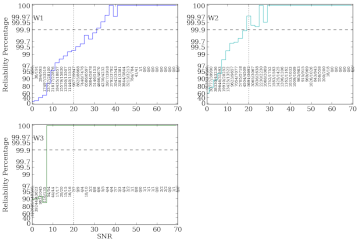 |
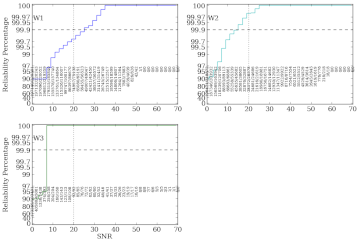 |
| Figure 4 - Example Data for Region 15, filtered for blends | |
The internal reliability test, therefore, when performed using the All-Sky Catalog as the truth table, shows that 3-Band WDB also achieves 99.9% reliability for sources SNR ≥ 20 sources in W2 and W3 if filtered for blending and confusion effects. W1 achieves 99.8% internal reliability as may be expected if the truth table is also 99.9% reliable. This behavior is identical to the All-Sky Catalog when it is compared against its internal reference sources.
Test Regions 2 and 13 through 18 were also compared with the 2MASS Catalog in an identical fashion as for the All-Sky Catalog. Refer to that section for a description of the source selection criteria and comparison methods.
Roughly 4 million sources were compared with the 2MASS Catalog. Figure 5a shows the fraction of WISE 3-Band sources that have direct counterparts in the 2MASS Catalog for each magnitude bin, while 5b shows the cumulative fractions. 99.9% of the WISE stars have a 2MASS counterpart from magnitudes 11 to 14, similar to the All-Sky Catalog. Past 14.0, the completeness of the 2MASS Catalog impacts the matching fraction.
The unmatched bright sources were investigated by hand again, and they were found to be either high proper motion sources, or binary/multiple sources. After going the the recovery process, nearly all the bright sources have been found, as shown by the thicker curves in Figure 6.
Therefore, the WISE 3-Band WDB is found to achieve 99.9% reliability for W1/W2 sources brighter than 14th magnitude in an identical fashion as the All-Sky Catalog.
A deeper comparison with the 2MASS data set is possible by using the 2MASS "Combined Calibration Field Source Table", available from IRSA Gator. These calibration data were derived from regions of the sky that had been covered several thousand times. The spatial coverage is small, but the depth has been increased to roughly K = 18. 2 of the 5 regions considered for the All-Sky Catalog were also covered during the 3-Band WDB (90013 and 90191). The initial results are presented in Figure 7.
As before, a number of bright WISE sources were not matched in the deep 2MASS data when searching using the standard 3" radius, so they were recovered using a 10" search radius and brightness matching (Figure 8). The reliability requirement is now met easily for all 3 bands; in fact, all but one of the sources with a WISE SNR ≥ 14 have counterparts in the 2MASS deep calibration data for these selected fields. The one "source" that was not matched turns out to be a latent of an extremely bright source, HD 28086 (K = 2.55), that was not otherwise filtered out.
An assessment of the reliability of WISE 3-Band source extractions using Spitzer Space Telescope data as the truth table was run in an identical fashion to 4-band All-Sky Catalog. The results are again similar, indicating that the 3-Band Database shares very similar reliability characteristics with the All-Sky Catalog.
Unfortunately, only one of the seven SWIRE/COSMOS fields used for the All-Sky analysis were covered during the 3-Band survey. ELAIS-N2 was rerun here, and the resulting reliability is very good, with all sources with SNR ≥ 10 being recovered (Figure 9).
The results show that 100% the WISE sources with SNR ≥ 10 in the ELAIS-N2 field have matching Spitzer entries, when binarity and extended source emission are taken into account.
Unlike the extragalactic fields, all four of the star forming regions analyzed for the All-Sky Catalog were covered in the 3-Band survey. Because of the very extensive nebulosity in Ophiuchus, we ignore that field here, but results are given for Chamaeleon, Perseus, and Serpens (Figures 10, 11, and 12). As in the ELAIS-N2 field, 100% of the sources with SNR > 10 were recovered after inspection for multiplicity and nebulosity. (For Serpens, 100% of all sources were recovered!)
In summary, the ELAIS-N2 and three of the CLOUDS fields demonstrate that the WISE 3-Band WDB sources are very reliable when compared with Spitzer observations, as was the case with the All-Sky Catalog.
In light of the much reduced sensitivity of W3 during the 3-Band cryogenic phase of the survey, a very legitimate concern is the reliability of sources that are detected only in the W3 band. By "detection", we mean that w3snr > 5, but w1snr and w2snr < 5. There are approximately 274,000 such sources contained within the 3-Band WDB that meet these criteria.
All these sources were compared against the All-Sky Catalog using a 10" search radius. A match was declared if either the r_allsky < 3 or | w3mpro - w3mpro_allsky | < 0.75. At first glance, the results (Figure 13) are not good. Only 25-30% of the W3-only sources have a corresponding entry in the All-Sky Catalog.
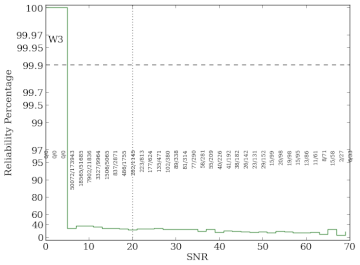 |
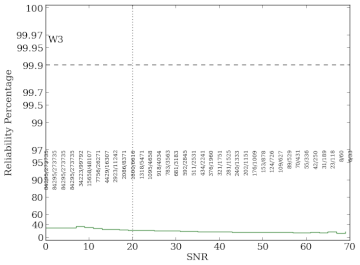 |
| Figure 13a - Fraction of W3-only sources that have matches in the All-Sky Catalog per SNR bin. | Figure 13b - The cumulative fraction of W3-only sources that have matches. |
Visual inspection of several dozen of the moderate SNR sources (~ 20) shows that the vast majority of them are gradients within nebulosity that triggered the source selection algorithm. That they do not match with the All-Sky Catalog is not surprising given that minor variations in the gradients due to noise will greatly affect where the selection algorithm places the source. There are astrophysical "sources" at most of these locations, just not "point sources" that can be consistently located from one data set to the next.
Finally, the very highest SNR W3-only sources tend to be either very bright, saturated stars that thwarted the W1/W2 photometry algorithm so that no believable W1 or W2 magnitudes could be obtained, or they are artifacts associated with tile edges near the survey boundaries. In fact, of the 100 highest SNR sources (w3snr ≥ 84.9), 56 are very bright stars (often M giants), only 22 of which have All-Sky counterparts due to the saturation problems. 2 sources are extremely bright optical ghosts that could not be flagged by the artifact identification routines. The remaining 42 sources are all defects associated with just 4 tiles: 0097p726, 0419p530, 0719m561, and 2384m107; 2384m107 is by far the worst offender. All 4 tiles have a single frame that contains a bright satellite trail; in three of the tiles there were only 2-4 coverages due to being located on either the edge of the survey region or on the edge of the W3 saturation gap (see Section VII.1.a.ii for the explanation of the saturation stripe and Section VII.7.5.a for the achieved coverage maps including the survey boundaries), and so it is not surprising that the trail made it through the coadd process. (In each of these tiles, there are many more coverages in W1 and W2; the W3 saturation reduces the number of useful frames for W3.) 2384m107 has 13 coverages, but is contaminated by moonlight, and so the coadder has also allowed the satellite trail to pass. Interestingly, 16 of these 42 sources actually have counterparts in the All-Sky Catalog, but these are chance associations with real stars that are far fainter than the artifacts.
This association of unreliable sources with the survey boundaries can be seen in Figure 14, where all W3-only sources with SNR > 20 are plotted. Sources associated with the edges of the saturated stripes are especially obvious as are a few with the survey boundaries.
In summary, the apparent reliability of W3-only sources in the 3-Band WDB appears to be poor when compared against the All-Sky Catalog, especially those with very high SNR that are either saturated stars or are completely spurious. However, most of these unmatched "sources" are in fact extended nebulosity that is difficult to locate repeatably. To improve the reliability of these sources, constrain the source selections to those that have good All-Sky association flags, or do a visual inspection of the imaging data to better understand the nature of a given source.
Last update: 2011 July 31


